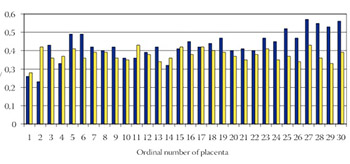Quantitative Research of Capillaries in Terminal Villi of Mature Placentae
DOI:
https://doi.org/10.17305/bjbms.2010.2714Keywords:
older pregnant women, placenta, terminal villi, capillaries, stereologyAbstract
Advanced maternal age is known to be a risk factor for placental dysfunctions. The most common obstetric complications among older women would be considered as follows: gestational diabetes; preeclampsia; placenta praevia; preterm premature rupture of membranes and the risk of preterm delivery. The aims of research were to determine the impact of maternal age on the structure of terminal villi. The study was conducted on 60 human placentae of term pregnancy divided into two groups: the control group (30 placentae in pregnant women of age between 20 and 34) and the experimental group (30 placentae in pregnant women of 35 years of age and older). Stereological methods were applied to determine the volume density, surface density, total volume and total capillary surface area in terminal villi of placenta. The mean value of volume density of capillaries in terminal villi of placentae in older pregnant women is: Vvkks = (0,376 ± 0,033) mm°, and the mean value of total volume is: Vkks = (157,047 ± 25,022) cm3. The mean value of surface density is: Svkks = (64,783 ± 2,543) mm-1, and the mean value of total surface area is: Skks = (29,959 ± 7,873) m2. Volume density of capillaries in terminal villi of placentae is significantly lower in older pregnant women (p<0,001) in comparison to the younger pregnant women. The total volume, surface density and total capillary surface area in terminal villi of placentae are also significantly lower in older pregnant women (p<0,005) in comparison to the younger pregnant women. Statistically significant lower values of volume density, total volume, surface density and total capillary surface area indicate that there is a decreased metabolic transfer between mother and foetus.
Citations
Downloads

Downloads
Published
How to Cite
Accepted 2017-11-24
Published 2010-05-20









